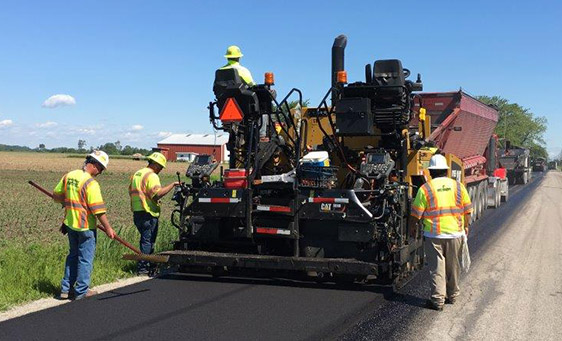Reimagine Your Space: Hot Mix Asphalt Paving for Angled Parking Lot Tasks
Reimagine Your Space: Hot Mix Asphalt Paving for Angled Parking Lot Tasks
Blog Article
Unlocking the Tricks of Warm Mix Asphalt Modern Technology
Checking out the depths of hot mix asphalt innovation discovers a world where precise procedures and accurate solutions converge to shape our roadways and facilities. The fusion of accumulations, fillers, and binders isn't just a building task but a tactical orchestration of resilience and effectiveness. As we peer into the complex dance of parts, a tapestry of strength and sustainability unravels. What exists underneath this surface of asphaltic proficiency, and what tricks wait to be introduced in the world of paving advancements?
Relevance of Warm Mix Asphalt
Hot Mix Asphalt plays a critical duty in modern-day infrastructure development due to its durability and cost-effectiveness. As the most generally utilized leading material for roads, highways, and auto parking great deals, Warm Mix Asphalt offers an array of advantages that contribute to its relevance in construction jobs.
The sturdiness of Warm Mix Asphalt comes from its structure, that includes aggregates, binder, and filler materials that are carefully selected and blended to fulfill particular efficiency needs. This exact combination causes a solid and adaptable pavement that can sustain constant use without substantial damage. Additionally, Hot Mix Asphalt is 100% recyclable, additional improving its sustainability and environmental advantages. Generally, the relevance of Warm Mix Asphalt in framework development can not be understated, as it remains to be a foundation of modern-day construction techniques.
Elements of Asphalt Mixes
The structure of asphalt mixes consists of carefully picked aggregates, binder, and filler products that are important for attaining specific efficiency demands. Accumulations are the main component of asphalt blends, providing toughness and security. The binder, usually asphalt or asphalt cement, holds the aggregates with each other and supplies versatility and sturdiness to the mix.
The mix and percentage of these parts play a considerable duty in figuring out the top quality and performance of the asphalt mix. Designers carefully develop the mix to satisfy certain demands, thinking about factors like web traffic quantity, environment problems, and pavement life expectancy. Correct option and harmonizing of accumulations, binder, and fillers are crucial for producing resilient, resilient asphalt sidewalks.
Mixing and Production Methods

Once the aggregates are picked, the binder, usually asphalt concrete, is included in bind the materials with each other. The binder's top quality and quantity substantially affect the mix's flexibility, strength, and resistance to ecological factors. In addition, fillers like hydrated lime or Portland concrete may be integrated to boost specific features of the asphalt mix, such as its workability or wetness resistance.
During production, the aggregates and binder are warmed, typically between 250-325 ° F(121-163 ° C ), to help with blending and ensure appropriate layer of the aggregates. The blending procedure must be detailed to achieve a homogeneous mix that advertises the desired performance attributes of the asphalt. Different methods, such as batch blending or drum blending, are employed to accomplish top notch and constant asphalt mixes for construction projects.
Factors Impacting Asphalt Performance
Factors influencing asphalt performance incorporate an array of variables that impact the sturdiness, long life, and overall top quality of regrading asphalt pavements. One crucial variable is the high quality of products used in the asphalt mix.

Environmental problems also affect asphalt performance. Temperature variations, wetness infiltration, and traffic lots can all affect the structural stability of the sidewalk. Design factors to consider, such as sidewalk density and drain, are vital in ensuring the lasting performance of the asphalt pavement. By thoroughly taking into consideration these service providers, designers and factors can enhance asphalt performance and improve the life span of sidewalks.
Lasting Practices in Asphalt Innovation

WMA allows for the production and positioning of asphalt blends at reduced temperature levels compared to standard hot-mix asphalt, resulting in reduced energy intake and greenhouse gas discharges. The use of permeable asphalt blends can aid reduce stormwater drainage problems by permitting water to penetrate via the sidewalk and right into the ground, advertising all-natural water filtering and reenergize processes.
Verdict
Finally, warm mix asphalt innovation plays an important role in contemporary facilities growth because of its longevity and cost-effectiveness. By thoroughly balancing parts, utilizing correct blending methods, and thinking about different variables, designers can develop top quality asphalt mixes that hold up against hefty website traffic tons and harsh climate condition. Embracing lasting practices, such as utilizing warm-mix technologies and recycled materials, additionally improves the environmental friendliness of asphalt innovation.
Mixing and production strategies in warm mix asphalt modern technology entail the exact combination and processing of accumulations, binder, and fillers you could try here to produce my response a high-performance and durable asphalt mix.Factors affecting asphalt performance encompass a variety of variables that impact the sturdiness, durability, and general top quality of asphalt sidewalks. Sustainable methods in asphalt technology incorporate numerous initiatives aimed at reducing the environmental effect of asphalt manufacturing and paving procedures. By integrating recovered asphalt pavement (RAP) and recycled asphalt shingles (RAS) into new asphalt blends, the industry can considerably minimize the intake of raw products and power, while additionally decreasing land fill waste.
WMA permits for the manufacturing and positioning of asphalt blends at reduced temperatures compared to typical hot-mix asphalt, resulting in decreased energy intake and greenhouse gas discharges.
Report this page